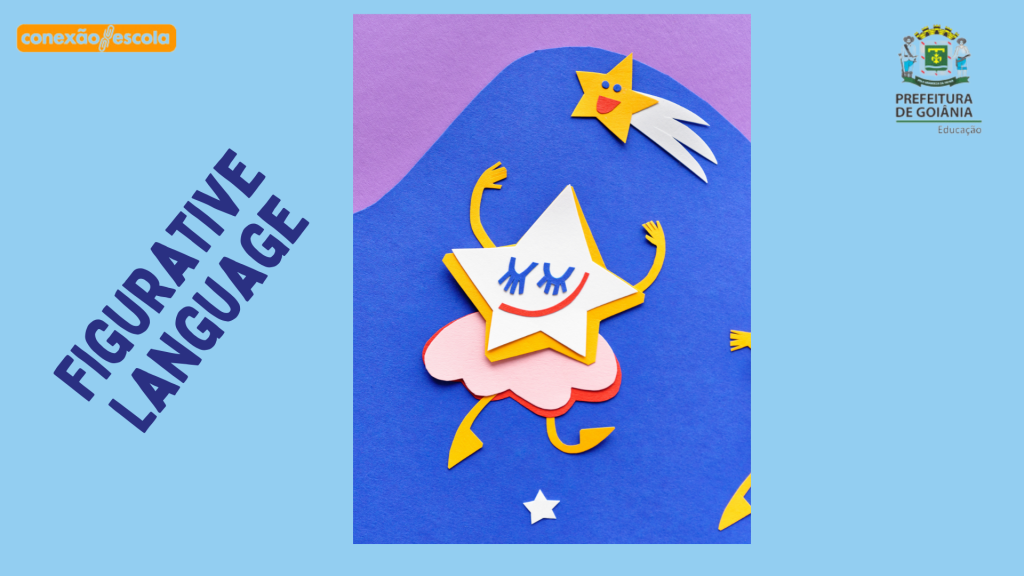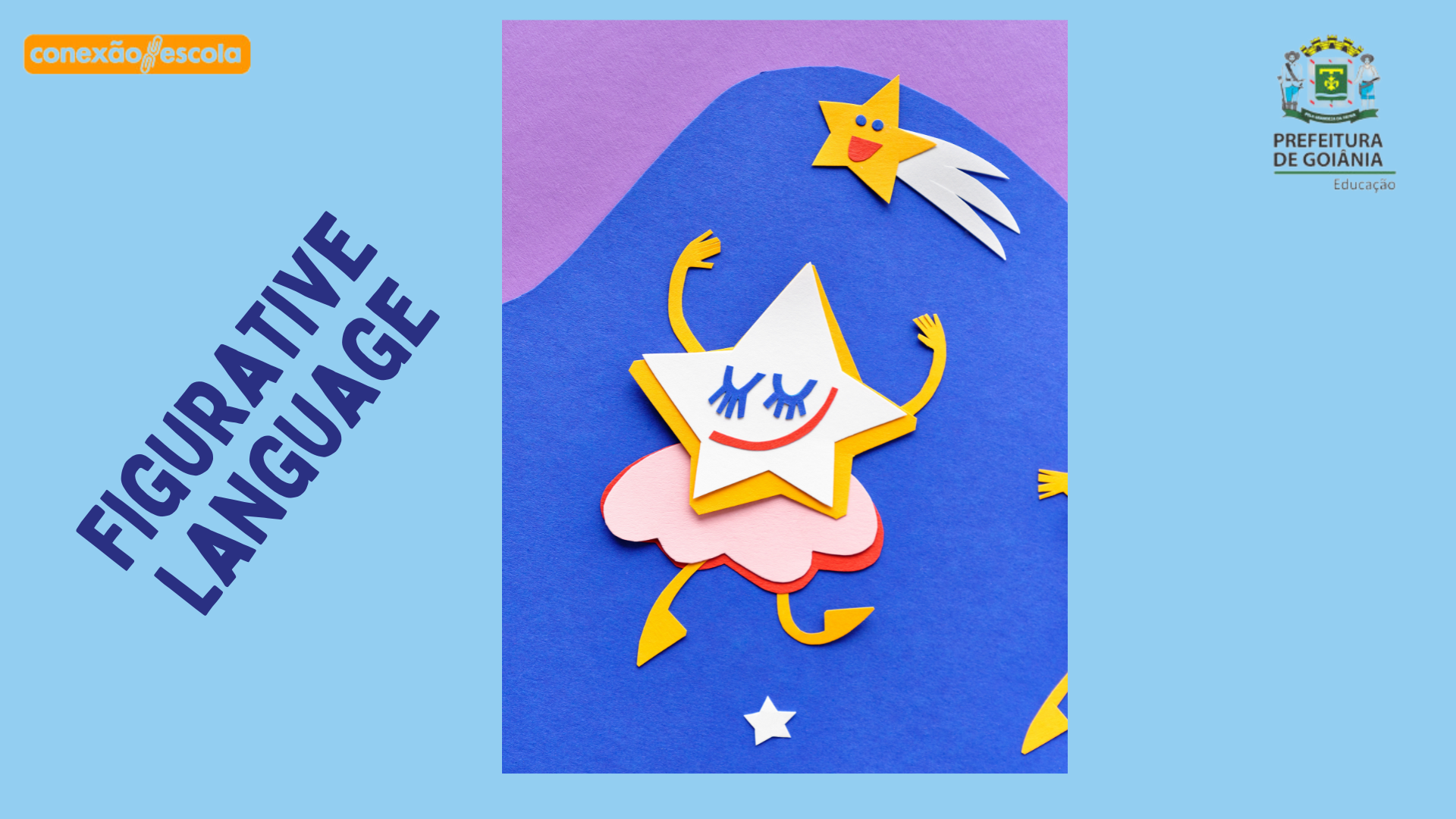Esta proposta de atividade de Língua Inglesa com base no DC/GO – Ampliado e é destinada aos estudantes do 8º Ano do Ensino Fundamental Anos Finais.

Imagem criada no canva.com
Figurative Language: Unlocking Depth in Communication
Figurative language is a tool that authors, poets, and speakers use to add richness, vividness, and layers of meaning to their words. It goes beyond the literal meaning of words to create effects that appeal to the imagination, evoke emotions, or offer fresh perspectives on familiar ideas. By using figurative language, writers can convey complex ideas more powerfully and succinctly, often making their writing more memorable.
There are several common types of figurative language, each serving a unique purpose:
- Simile: This is a comparison between two different things using the words “like” or “as.” It highlights similarities between otherwise unrelated concepts, helping the reader or listener visualize or understand the comparison more clearly. For example, “Her smile was like sunshine” suggests warmth and brightness through this comparison.
- Metaphor: Similar to a simile, a metaphor also compares two things, but does so directly without using “like” or “as.” Metaphors allow for a deeper, more implicit connection. For example, “Time is a thief” suggests that time, like a thief, steals moments from our lives.
- Personification: This gives human characteristics to non-human objects, animals, or abstract ideas. Personification brings these subjects to life in a way that allows readers to relate to or engage with them emotionally. For instance, “The wind whispered through the trees” portrays the wind as if it could communicate like a person.
- Hyperbole: This is an intentional exaggeration for emphasis or humor. Hyperboles are not meant to be taken literally but are used to stress the intensity of a situation. An example would be, “I’ve told you a million times,” which expresses frustration rather than a literal count.
- Onomatopoeia: This type of figurative language uses words that imitate the sounds they describe, such as “buzz,” “clang,” or “sizzle.” Onomatopoeic words can make descriptions more vivid and immersive by mimicking real-world sounds.
- Oxymoron: This involves placing two contradictory terms together to create a paradoxical effect, such as “bittersweet” or “deafening silence.” Oxymorons force readers to think more deeply about the complex and sometimes contradictory nature of emotions, ideas, or situations.
- Alliteration: Although often categorized under sound devices, alliteration—the repetition of consonant sounds at the beginning of words in a sentence or phrase—can also contribute to the figurative tone of language. It creates a musical rhythm or draws attention to a particular phrase, such as in “Peter Piper picked a peck of pickled peppers.”
- Symbolism: This is when an object, action, or idea represents something beyond its literal meaning. For example, a dove often symbolizes peace, and a red rose is commonly associated with love or passion. Symbols enrich a story by adding layers of meaning that can be interpreted in various ways.
Figurative language enriches communication by making it more creative, expressive, and engaging. It allows speakers and writers to convey more than just information—they can evoke emotion, paint vivid pictures, and engage the listener’s or reader’s imagination. Whether in literature, everyday conversation, or poetry, figurative language helps to shape the way we understand and experience the world.
Glossary:
Thief – Ladrão
Whispered – Sussurrou
Vividness – Vivacidade
Warmth – Calor
Steals – Rouba
Memorable – Memorável
Brightness – Brilho
Sizzle – Chiar
Bittersweet – Agridoce
Engaging – Envolvente
Layer – Camada
Depth – Profundidade
Emphasis – Ênfase
Humor – Humor (used differently in Portuguese, meaning “mood”)
Abstract – Abstrato
Leia a história em quadrinhos abaixo e responda as questões sobre a mesma:
Glossary:
Words – Palavras
Flies – Voa
Means – Significa
Wings – Asas
Passes – Passa
QUESTION 01
No primeiro quadrinho, a garotinha entende
(A) que o tempo passa lentamente.
(B) que o tempo voa como um pássaro.
(C) que o tempo é valioso.
(D) que o relógio precisa de conserto.
QUESTION 02
No segundo quadrinho, a professora explica
(A) que o tempo realmente voa.
(B) que o tempo tem asas.
(C) que “o tempo voa” significa que ele passa rapidamente.
(D) que o tempo não pode ser medido.
QUESTION 03
Qual figura de linguagem a professora usou ao dar o exemplo de “Time flies”?
QUESTION 04
Desembaralhe as language figures abaixo:
(A) OTHRAMEPH –
(B) TRELALATIONI –
(C) ILMEIS –
(D) YRELOPBHE –
(E) NIFPOEITRASCINO –
| Autoria | Profª Drª Sueidy Lourencio |
| Formação | Letras: Português/Inglês – Doutorado em Educação |
| Componente Curricular | Língua Inglesa |
| Habilidades | (EF08LI05-A) Relacionar as partes verbais e não verbais de um texto para compreender as informações implícitas ou explícitas e inferir significados, para construir interações discursivas relacionadas aos sonhos e projetos futuros para o planeta. |
| Referências | MAKAR, Barbara W. Primary Phonics. 1. ed. Chicago: Modern Curriculum Press, 2018. KOUSTAFF, Lesley. Oxford Discover. 2. ed. v. 1. Oxford: Oxford University Press, 2018. FOLEY, Mike; HALL, Diane. New Total English Elementary student’s book, Essex: Pearson. Education Limited, 2011. |

